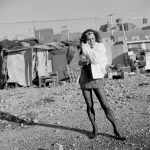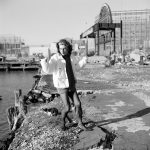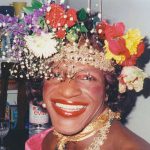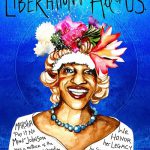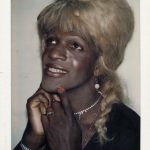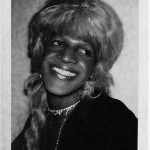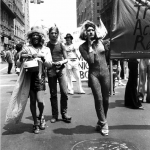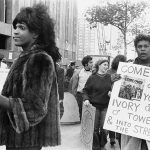- Rivera, in the “gay camp” at the Christopher Street Piers c. 2000
- photos by Val Shaff
- Sylvia Rivera in 1970.Kay Tobin / Courtesy of New York Public Library
Sylvia Rivera
Born: July 2nd, 1951 Died: February 19, 2002
What she did: Self-identified drag queen who fought tirelessly for transgender rights, as well as for the rights of gender-nonconforming people.
Facts:
- Sylvia was born as Ray Rivera, on July 2nd, 1951 in the Bronx, New York and lived most of her life in or near New York city; she was of Puerto Rican and Venezuelan descent.
- She was abandoned by her birth father José Rivera early in life and became an orphan after her mother committed suicide when Sylvia was 3.
- Sylvia was then adopted and raised by her Venezuelan grandmother, who voiced her disapproval not only of Rivera’s mixed background that made her skin darker than she preferred , but also of her behavior, which was deemed too effeminate for a boy.
- Sylvia began to wear makeup in fourth grade.
- Sylvia was bullied at home and at school, she shaved her eyebrows and wore makeup to school beginning in fourth grade, and was mocked and called faggot by classmates in sixth grade leading her to abandon formal education.
- At 10 years old she left home and began life as a sex worker, hustling near Times Square. On the streets, specifically 42nd Street in New York, she found an eclectic tribe of sex workers, street queens (as poor trans youth, some of whom performed sex work and/or were homeless, then identified themselves), drag queens, and members of the gay community.
- She gave herself the name “Sylvia Rivera” in a ceremony attended by some fifty of her friends and peers.
- Rivera and her peers were regularly beaten up by cops, johns, or even each other. Rivera would eventually serve 90 days on Riker’s Island, sent to a cellblock kept for perpetrators of “gay crimes”.
- Sylvia’s activism began during the Civil Rights Movement and continued through the movement against the Vietnam war and second-wave feminist movements.
- Rivera didn’t care about labels and definitions, throughout her life she referred to herself as a ‘half sister,’ a ‘drag queen,’ or a ‘transvestite.’
- Her attitude on her fluid identity further strengthened her position as a radical activist in the mainstream gay movement.
- One day, as Sylvia was hustling on 42nd, she spotted an older black queen — Marsha P. Johnson — who she was immediately drawn to.
- Marsha ended up inviting Sylvia out for a spaghetti dinner, and took her under her wing, teaching her how to apply her makeup and the rules of the street.
- The pair remained friends for the rest of their lives, and participated in many of the most significant early gay liberation struggles.
- She said she was a regular patron of the Stonewall Inn and was present On June 28th, 1969, when the Stonewall Inn was raided, Sylvia was 17.
- At the time of the incident, Rivera was there with her close friend and fellow activist Marsha P. Johnson.
- This became the StoneWall Riots, when gay men, lesbians, bisexual people, drag queens, street people and trans people rose up against what started as a routine raid by the police.
- The incident resulted in five days of rioting, patrons of the bar, the greater gay community, homeless youth, African Americans, and Puerto Ricans protested…and won.
- The protests contained: hurled barricades, broken windows, firebombs, cries of “occupy—take over, take over,” ”Fag power,” and “Liberate the bar!”
- Rivera stated that she had told her comrades as the riots began, “I’m not missing a minute of this.” “It’s the revolution!” She emphasized this fact in other interviews. “We were the frontliners. We didn’t take no shit from nobody […] We had nothing to lose.”
- Sylvia Rivera would always be quick to redress those who thought she threw the first Molotov cocktail at the historic Stonewall riot on June 28, 1969. “I have been given the credit for throwing the first Molotov cocktail by many historians, but I always like to correct it,” she said in 2001. “I threw the second one. I did not throw the first one!”
- Regardless of the degree of her participation in the frenzy that took place at the Stonewall Inn that night, Sylvia laid low for a few months afterward for unknown reasons.
- When her friend, Marsha P. Johnson, told her about meetings of the Gay Liberation Front (GLF), she jumped at the chance to become involved in the activity emerging in the aftermath of Stonewall.
- Despite Sylvia’s enthusiasm to be involved in these newly formed activists groups, such as the GLF and the Gay Activists Alliance (GAA) that would split from the GLF, from the beginning her identities as a street worker, drag queen, poor, and a Latina were troubling to the largely white, middle-class activist groups
- She challenged the way the predominantly white gay and lesbian community approached activism from a middle class perspective.
- Rivera wanted their activism to be more progressive, to include in their fight the rights of transgender individuals, including people of color, the homeless, and the incarcerated.
- Her experiences made her more focused on advocacy for those who, in her view, mainstream society and the assimilationist sectors of the lesbian, gay, bisexual, and transgender (LGBT) communities were leaving behind.
- She fought for herself but most importantly for the rights of people of color and low-income LGBT people.
- As someone who suffered from systematic poverty and racism, Rivera used her voice for unity, sharing her stories, pain, and struggles to show her community they are not alone.
- She amplified the voices of the most vulnerable members of the gay community: drag queens, homeless youth, gay inmates in prison and jail, and transgender people.
- In 1970, Rivera and Johnson co-founded Street Transvestite Action Revolutionaries (STAR) and later a home called STAR House. STAR offered services and advocacy for homeless queer youth, and fought for the Sexual Orientation Non-Discrimination Act in New York. SONDA prohibits discrimination on the basis of sexual orientation in employment, housing, public accommodations, education, credit, and the exercise of civil rights.
- She was banned from New York’s Gay and Lesbian Community Center, after she destroyed a desk in the lobby, enraged because she felt the center did not address the needs of transgender homeless youths who slept in front of it.
- Rivera had supported the passing of the Gay Rights Bill in New York, which would bar discrimination on the basis of sexual orientation, because it had originally included support for the transgender community.
- But by the time the Gay Rights Bill passed in New York in 1986, 17 years after Stonewall, language denouncing gender discrimination had been removed. “They have a little backroom deal without inviting Miss Sylvia and some of the other trans activists…The deal was, ‘You take them out, we’ll pass the bill,’” she said in 2001.
- She felt the community she and her trans siblings had fought for all these years at Stonewall and beyond, been arrested for and beaten for, had sold them up the river. When she discovered this, Sylvia’s response was: “Hell hath no fury like a drag queen scorned.”
- She also stopped working with the GLF and GAA and the gay rights movement in general after three or four years because the organizations began to both publicly denounce and ignore her.
- She would return some 20 years later for the 25th anniversary of Stonewall, asked to participate by the pride parade’s organizing body. “The movement had put me on the shelf, but they took me down and dusted me off,” she said in 1995. “Still, it was beautiful. I walked down 58th Street and the young ones were calling from the sidewalk, ‘Sylvia, Sylvia, thank you, we know what you did.’ After that I went back on the shelf. It would be wonderful if the movement took care of its own.”
- At the 1973 Christopher Street Liberation Day Rally in New York City, Rivera, representing STAR, gave a brief speech from the main stage in which she called out the heterosexual males who were preying on vulnerable members of the community.
- Rivera espoused what could be seen as a third gender perspective, saying that LGBT prisoners seeking help “do not write women. They do not write men. They write to STAR.”
- At the same event, she got onstage amidst boos from the crowd. “I had to fight my way up on that stage…people that I called my comrades in the movement literally beat the shit out of me,” Rivera would say later. speech amid boos and shouts and starts her “Y’all Better Quiet Down,” speech, stating, “You go to bars because of what drag queens did for you, and these bitches tell us to quit being ourselves!” “You all tell me, go and hide my tail between my legs. I will no longer put up with this shit. I have been beaten. I have had my nose broken. I have been thrown in jail. I have lost my job. I have lost my apartment. For gay liberation, and you all treat me this way? What the fuck’s wrong with you all? Think about that!”
- After the rally, Rivera broke down, disbanded STAR, and left activism for two decades. Sadly, she still continued to struggle with homelessness and drug addiction.
- Her impact was not in vain, and her lifelong activism ensured that the “T” was placed in the LGBTQ rights movement.
- In May 1995, Rivera tried to commit suicide by walking into the Hudson River.
- Save an extensive interview to gay journalist Randy Wicker in which she discussed her suicide attempts, Johnson’s life and death, and her advocacy for poor and working-class gays made homeless by the AIDS crisis.
- In the last five years of her life, Rivera renewed her political activity, giving many speeches about the Stonewall Uprising and the necessity for transgender people, including drag queens and butch dykes, to fight for their legacy at the forefront of the LGBT movement.
- She traveled to Italy for the Millennium March in 2000, where she was acclaimed as the “mother of all gay people”.
- In early 2001, after a service at the Metropolitan Community Church of New York referring to the Star of Bethlehem announcing the birth of Jesus, she decided to resurrect STAR as an active political organization (now changing “Transvestite” to the more recently coined term “Transgender,” which at that time was understood to include all gender-nonconforming people).
- STAR fought for the New York City Transgender Rights Bill and for a trans-inclusive New York State Sexual Orientation Non Discrimination Act. STAR also sponsored street pressures for justice for Amanda Milan, a transgender woman murdered in 2000.
- Rivera attacked Human Rights Campaign and Empire State Pride Agenda as organizations that were standing in the way of transgender rights. On her deathbed she met with Matt Foreman and Joe Grabarz of ESPA to negotiate transgender inclusion in its political structure and agenda.
- Rivera died during the dawn hours of February 19, 2002 at St. Vincent’s Hospital, of complications from liver cancer.
- Activist Riki Wilchins noted, “In many ways, Sylvia was the Rosa Parks of the modern transgender movement, a term that was not even coined until two decades after Stonewall”.
Legacy
- Metropolitan Community Church of New York, New York’s queer youth shelter is called Sylvia’s Place in her honor.
- The Sylvia Rivera Law Project is dedicated “to guarantee that all people are free to self-determine gender identity and expression, regardless of income or race, and without facing harassment, discrimination or violence”.
- In 2005, the corner of Christopher and Hudson streets was renamed “Sylvia Rivera Way” in her honor. This intersection is in Greenwich Village, the neighborhood in New York City where Rivera started organizing, and is only two blocks from the Stonewall Inn.
- In 2015 a portrait of Sylvia Rivera was added to the National Portrait Gallery.
- In 2016 Sylvia Rivera was inducted into the Legacy Walk.
“I left home at age 10 in 1961. I hustled on 42nd Street. The early 60s was not a good time for drag queens, effeminate boys or boys that wore makeup like we did. Back then we were beat up by the police, by everybody. I didn’t really come out as a drag queen until the late 60s. when drag queens were arrested, what degradation there was. I remember the first time I got arrested, I wasn’t even in full drag. I was walking down the street and the cops just snatched me.
People now want to call me a lesbian because I’m with Julia, and I say, “No. I’m just me. I’m not a lesbian.” I’m tired of being labeled. I don’t even like the label transgender. I’m tired of living with labels. I just want to be who I am. I am Sylvia Rivera. Ray Rivera left home at the age of 10 to become Sylvia. And that’s who I am.”
- Marsha P. Johnson
- “Ladies and Gentlemen” Marsha Johnson | Andy Warhol
- Johnson hands out flyers at NYU in the 1970s
Marsha P. Johnson
Born: August 24, 1945 Died: July 6, 1992
What she did: Transgender Woman and LGBTQ Activist
Facts:
- Marsha was born August 24, 1945 in Elizabeth, New Jersey. She was one of 7 children born to her working class parents, Malcolm and Alberta.
- As a child, Marsha attended an African Methodist Episcopal Church and was a devout Christian throughout her life.
- By the time she was 5, Marsha began wearing dresses. She was teased and harassed by neighborhood boys, causing her to dress as a boy again.
- Marsha was also sexually assaulted as a young child by a 13-year-old boy.
- Once Marsha graduated from high school in 1963, she got the fuck out. With nothing but $15 and a bag of clothes, Marsha eventually found her way to Greenwich Village, New York, where she worked waiting tables.
- Even though in 1950, New York downgraded sodomy from a felony to a misdemeanor, rampant criminalization of LGBTQ people was common. They weren’t allowed to dance in public, bars were banned from serving them, and cross-dressing was illegal.
- When she first arrived in New York, Marsha alternated between using her birth name and going as Black Marsha.
- She worked as a sex worker and was arrested frequently, later saying she stopped counting after her 100th arrest.
- She was living in a high risk environment, working in seedy hotels and was even shot. She would frequently sleep under tables in the Flower District of Manhattan.
- Marsha later changed her name to Marsha P. Johnson, saying the P stood for “pay it no mind.” This was like her catchphrase when people questioned her about her gender. One time, she used the phrase on a judge who thought it was funny and released her.
- Marsha also performed as a drag queen. Because she couldn’t afford to purchase clothing and accessories, Marsha got creative. Remember the tables she would sleep under in the Flower District? Those tables were used for sorting flowers and she would decorate her hair with the extras, which became part of her signature look.
- Marsha would also dress in flowing robes, shiny dresses, red plastic
high heels, and bright wigs because she was born to stand out. - She performed with a few different drag groups including Hot Peaches and The Angels of Light.
- In 1975, Marsha was photographed by Andy Warhol as part of his “Ladies & Gentlemen” Polaroid series.
- The Stonewall Inn was the only gay bar in NYC where dancing was allowed.
- To protect the Stonewall Inn against Lilly Law, Alice Blue Gown, and Betty Badge (also known as undercover cops), patrons were greeted by a bouncer who inspected them through a peep hole to see if they recognized them or if the patron “looked gay.”
- Staff would also stow away extra liquor behind secret panels so they could get back up and running quickly after a raid.
- The Stonewall Inn also bribed the cops to tip them off if there was going to be a raid.
- When raids did occur, the police would line up patrons and inspect their IDs. Anyone without an ID, dressed in drag, women NOT wearing 3 pieces of feminine clothing, or anyone they fucking felt like, would be arrested.
- Female police officers would also take patrons dressed as women to the bathroom and ‘verify their gender.’
- At 1:20 a.m. on June 28, 1969 9 police officers approached the Stonewall Inn and shouted “Police! We’re taking the place!”
- There were two undercover cops already in the bar, gathering evidence and, when they gave the signal, backup came. People tried to escape but the police had barred the exits.
- During the raid, some of the officers began sexually assaulting the women while frisking them. Some people were released by the police, but instead of getting the fuck out, they stood outside and a crowd began to form.
- Between 100-150 people gathered and some began taunt the cops by performingor saluting the cops sarcastically.
- As the cops began loading people into patrol wagons, there were shouts from the crowd of “Gay power!” and others sang “We Shall Overcome.” Tensions mounted between the police officers and the growing crowd and finally exploded when a woman being arrested tried to escape and was beaten with a baton. Some allege this was Storme DeLarverie, including Storme herself. Storme was a lesbian who frequented the Stonewall Inn and a gay rights activist. She recalls she shouted at the crowd “Why don’t you guys do something?” Finally things boiled over and the police’s attempts to control the crowd only antagonized them more.
- The police retreated inside the bar, completely overwhelmed by the crowd. In response, the crowd tried to bust into the bar and set it on fire. The officers managed to escape and the fire was extinguished. The crowd eventually grew into 1,000s and the uprising lasted until July 1 st .
- The Stonewall Uprising was not the beginning of the gay rights movement, but was certainly a watershed moment that resulted in mass awareness across the country and encouraged members of the LGBTQ to mobilize. It sparked the birth of the Gay Liberation Front, the first group to publicly advocate for gay rights.
- The Stonewall Uprising also gave birth to the first pride parade which was held on the 1 year anniversary.
- After the Stonewall Uprising, Marsha teamed up with her friend and fellow uprising participant, Sylvia Rivera. Together, they founded the organization Street Transvestite Action Revolutionaries, or STAR, a group dedicated to helping homeless youth and trans women of color.
- Marsha was also a member of the Gay Liberation front and attended the first pride parade.
- In 1970 Marsha and fellow Gay Liberation Front members staged a sit in at New York University after the school canceled a dance that was sponsored by gay rights organizations.
- Marsha and Sylvia were notable presences at gay rights events. Unfortunately, just as today, there was discrimination within the LGBTQIA community and Marsha and Sylvia felt the impact of that when they were banned from the 1973 pride parade. The gay and lesbian committee putting on the event weren’t going to allow drag queens at the march.
- Marsha and Sylvia responded by marching in front of the fucking parade which is the level of defiant and salty I aspire to be. The march produced one of the best known photos of these powerful besties.
- When Marsha and Sylvia established the STAR House, a shelter for gay and trans youth, a shelter they paid for with money they made as sex workers, Marsha became known as the “drag mother.” So basically she became the mother figure for these kids who didn’t otherwise have supportive families.
- The shelter provided clothes, food, and support to the youths it housed.
- Though Marsha was an avid activist, she was still struggling just to live. She suffered her first mental breakdown in 1970 when she walked up and down Christopher Street, the same street the Stonewall Inn was on, naked. She would sometimes lash out and become aggressive. She called this side of her, Malcolm, which was her birth name. When she slipped into this persona, she would act masculine and aggressive.
- She struggled her whole life with homelessness, engaging in survival sex, and mental illness.
- As a marginalized person, she didn’t receive much help.
- In 1992, shortly after the pride parade, Marsha’s body was found floating in the Hudson River. While the police originally ruled it as a suicide, her friends insisted that she was not suicidal and noted the fact she had a massive wound in the back of her head. Sylvia was one of the people who argued against the suicide ruling, saying she had Marsha had made a pact to “cross the river Jordan (aka the Hudson River) together.”
- Witnesses came forward and reported they had seen Marsha being harassed by thugs and using homophobic slurs with her. There were also reports of a man who bragged at bars that he had killed a drag queen named Marsha.
- Despite ALL OF THIS, the police refused to look further into the case because it involved “a gay black man.”
- Marsha was cremated and her ashes were spread out over the Hudson River.
- In November 2012, activist Maria Lopez got the NYPD to re-open the case as a potential homicide. Marsha is remembered as a vivacious activist who worked so hard and did so much with so little.

